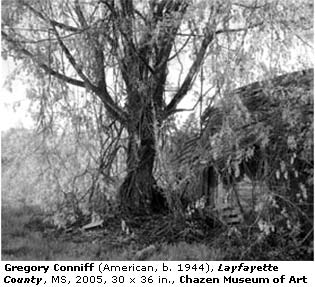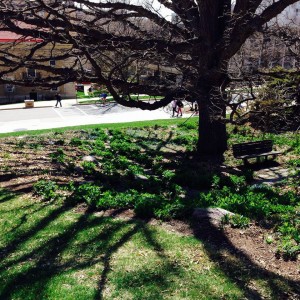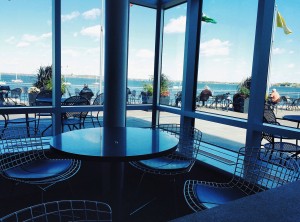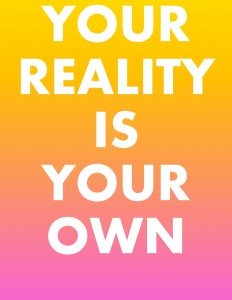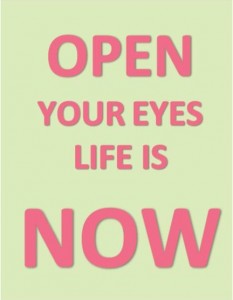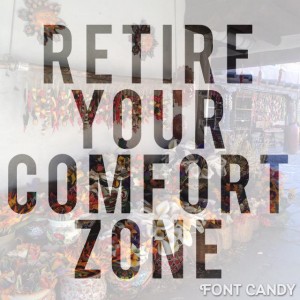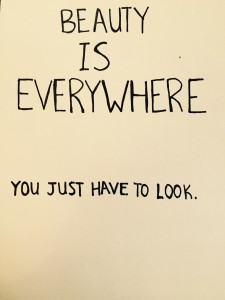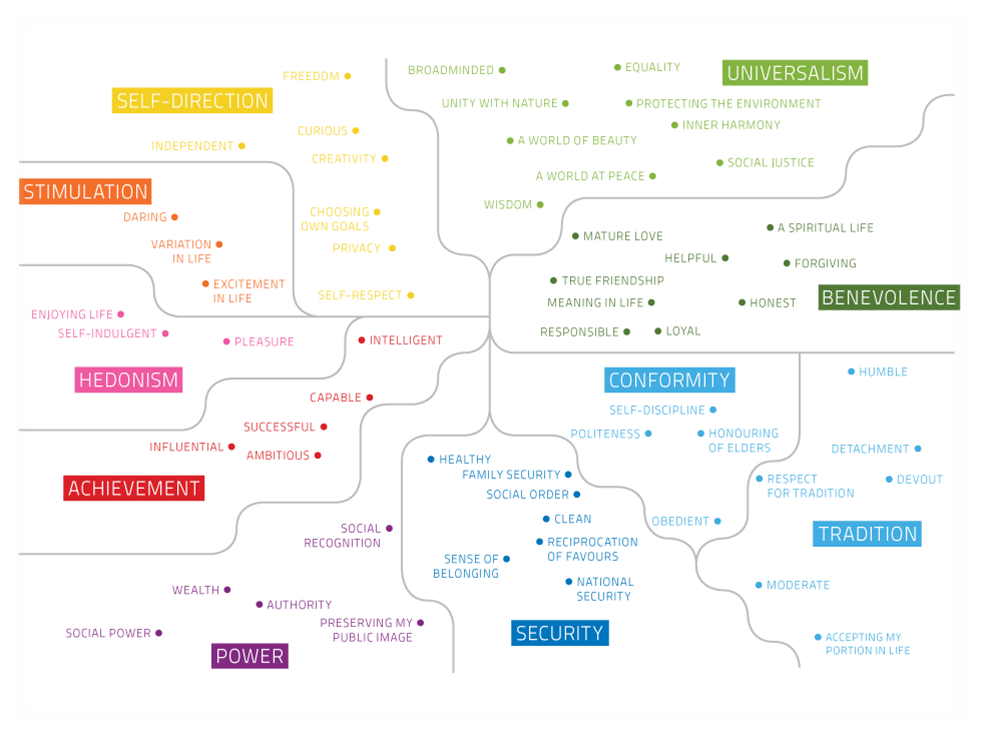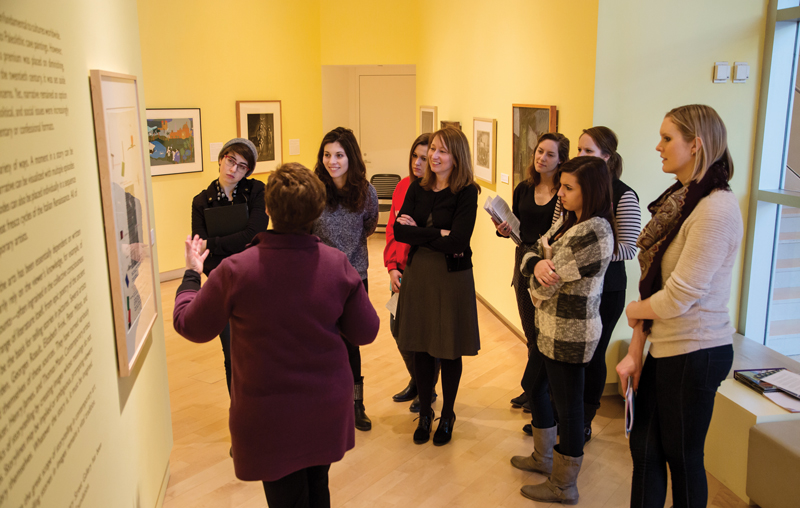
Diane and several beauty class students at the Madison Museum of Contemporary Art.  Photo Credit: Alex André
Well, 12 posts later, we’ve come to the last post in the series covering my course in aesthetics and business (aka/ approaching beauty) offered at UW-Madison, for undergraduate business majors.  This post basically walks through the last two classes in which the students took stock, reflected on their journeys, and thought about where they go from here.
(The photo (left) is from an article that ran in a UW-Madison magazine. Unlike my Jumper posts, it’s a quick read.)
As the course has come to an end, several people have asked me “What’s next with beauty? Will you do the course somewhere else?” The answer is, “Very possibly!” I am taking the next year to finish my dissertation on the American regional theater and Broadway, but then hope to return to beauty in fall 2016. A couple universities have already expressed interest in the class. We’ll see what actually comes to fruition. I’m also interested to explore possibilities beyond teaching the course again. A MOOC, perhaps? A publication? A grassroots movement? (Ok, the latter is a vainglorious aspiration; but in all seriousness, I’m more persuaded than ever that all high school and university students need a course like this–a course, essentially, in human development.)
And while the UW-Madison does not have plans to offer this particular course again (it was offered this year only because I pitched and designed the course as part of a one-time visiting guest lectureship), the business school does seem interested to continue its exploration of beauty and, at the very least, to include sessions on beauty as part of its ongoing Compass Leadership Program, which reaches hundreds of freshman each year. So, that’s terrific.
Creating More Beauty in the World
For my last session with the students I invited no outside guests; however, I did bring two artists into the room indirectly as I gave the students assignments to engage with their work. The first artist is the Madison-based photographer Greg Conniff.
Greg found me on artsjournal.com the second week I was in town and generously reached out to offer encouragement with the course and an essay he had written, The Work of Beauty, for a 2006 catalogue published in conjunction with an exhibition of his work at the Chazen Art Museum.
I read the essay and knew immediately that I would assign it for the last class. It’s a moving, inspiring, humorous and well-crafted reflection on finding and creating beauty where you live. Here is one of my favorite passages (particularly meaningful because I moved from New York City to a small suburban village in the Netherlands and I have struggled to feel at home here the past five years):
And where we are, most of us, most of the time, is home. The character of home is made of many things, one of which is local beauty, either natural or built. This came into focus for me late one night alone on a small bridge in my neighborhood during a glorious blizzard. There, along the bridge’s familiar concrete balustrade, I was surprised by a row of ducks, a mother and her young, that someone had sculpted from the snow. They fluoresced in the glow of a nearby streetlight while the flakes, which continued to fall, fattened them with a glittering down. In the sculpture of the ducks I felt the presence of someone who had absorbed much local beauty and who, when circumstances allowed, passed the favor along. I went home and got my camera and woke my wife to come and see.
* * *
It is in our homes and in our hometowns, between work and family, that we live the story of our lives. Our challenge is to make a setting for that story so rich and sustaining that we won’t want to seek relief from it by fleeing to some manufactured elsewhere— some tourist Eden, if you believe the brochures. Why not live in a place of the sort people travel to? We could do this if we understood better the sustaining relationship we can have with our local landscapes.
The students seemed to love Greg’s essay as much as I do and many included lines from it in their final video collages or in their portfolio journals. I asked the students to sit someplace beautiful while reading The Work of Beauty and then to document that place. Here are two examples:
I also asked them to reflect on what it would mean (personally speaking) to take responsibility for creating more beauty in the world. Among other things, they wrote about paying closer attention to people–whether strangers, colleagues, friends, or family; being authentic or genuine in their daily interactions; designing work spaces that are uplifting rather than demoralizing; passing along what they have learned in this class; and (like Greg) planting gardens.
***
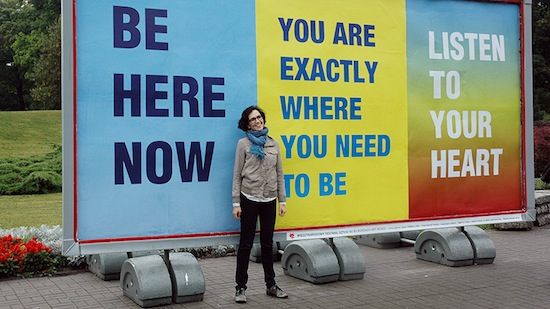 The other assignment I gave related to the recently (and tragically) deceased California-based artist Susan O’Malley.I didn’t know Susan personally but was aware of her work and know colleagues and friends of hers.
The other assignment I gave related to the recently (and tragically) deceased California-based artist Susan O’Malley.I didn’t know Susan personally but was aware of her work and know colleagues and friends of hers.
Here’s a passage from a moving eulogy written by JD Beltran, that was published in the Huffington Post:
She described her work as “making art that connects us to each other.” Simple, but enormously moving, it tapped into the mundane, and sometimes humorous, interactions of everyday life. Her projects included offering Pep Talks, asking for advice from strangers, installing roomfuls of inspirational posters, distributing flyers in neighborhood mailboxes, and conducting doodle competitions at high schools. Interested in shifting these otherwise commonplace exchanges into heightened experiences, her projects aspired to incite hope, optimism, and a sense of interconnectedness in our lives.
Christian Frock wrote, “All of O’Malley’s work, both as artist and curator, reflected a rare generosity and empathy for those around her — to the extent that her boundless enthusiasm sometimes baffled cynics unable to grasp the actual work of optimism. But she knew it was work and she took it very seriously. Under her professional interests on LinkedIn, O’Malley listed: ‘Making the world a better place. Staying positive in a world that does the opposite.”
When she died (just a few weeks into the term) I vowed to do something in the class to try to honor Susan’s legacy. I sent the students a link to the HuffPo article and some other information about Susan and her work and asked them each to create a mantra for the world–inspired in content from the beauty course and in design by Susan O’Malley’s work. Here are a few of their mantras.
Contemplating Values & Next Steps in Life
I spent a good chunk of my last regular session with the students doing an exercise with them using the Schwarz universal values. I first asked them to review a list of 58 values (see The Common Cause Handbook) and identify any that resonated. I then gave them the following sequential prompts:
- Go through the list again and mark the 10 values that are most important to you.
- Go through the list a third time and narrow that list down to 5 core values.
- Now, identify your top 10 and top 5 values on this map (also in the Common Cause Handbook).
What you see in the map is that all 58 values can be placed in one of ten universal value clusters, which are divided along two major axes:
- Self-enhancement (the pink, red & purple areas) as opposed to self-transcendence (the green areas);
- Openness to change (the orange and yellow areas) as opposed to conservation/preservation (the blue areas).
We then had a discussion about where students’ values were mostly clustered. In general, one would expect to hold values across the map but it is also not uncommon to hold values that cluster in one area. We noted that many had values clustered in the green (self-transcendence) section of the map.
We also talked about the career ambitions and next steps facing the students. Those graduating (all but a few students) expressed a combination of excitement and immense anxiety about upcoming moves to new cities and/or new jobs and/or to the unknown. I shared with the students a piece of wisdom that was passed along to me when I was in my 30s:
Burnout doesn’t arise because you are working too many hours; burnout is a result of living your life out of alignment with your values. If you are feeling burned out look at your list of values. There is probably some core value on that list that you are no longer upholding.
This Class in a Nutshell
Finally, in advance of the penultimate session I collected some reflections on the class from the students—including responses to the following question: If a friend asked you “What was that beauty class all about and what, if anything, did you get out of it?†what would you say? Now, clearly, I hold the power over their grades and their responses may have been influenced by this; but I was, nonetheless, curious how they would describe the class and its value. Here were some of their responses (abridged, in some cases)
- In this beauty class you discover not only what defines beauty and why it is important in business, but you learn about yourself and what you find beautiful and why. Your homework consists of exploring various beautiful experiences – sometimes it’s exploring what others find beautiful and other times it’s making your own experiences and discovering your own idea of what you find beautiful. It is unlike any other business class you will take – it is routed in experiences and exploration – not numbers, grades, and midterms.
- If a friend were to ask what the class was about, I would share that the course is designed to give business students an artistic perspective aimed at their everyday lives. Through a series of beautiful and art related experiences we reflect on our own personal tastes and aesthetics to ultimately gain some awareness for why we’re attracted to the things we are and what this means about us as a contributing member of a community and a person as a whole.
- It’s helped me think in a different way, to see different viewpoints and other softer aspects of business that usually get overlooked.
- It’s about forgetting about the fucking ROI for two seconds, stepping back, and realizing that there is a greater purpose to life than your damn material equity.
- It’s transforming us into people who care.
Presentation of the Video Collages:
For the final session the students were asked to create five-minute video collages. The aim was to give others a peek into their beauty portfolios and to reflect upon what they had learned about beauty and themselves over the course of the term. The students did beautiful work–and the experience of screening the videos for each other was all the more moving because many of the students were incredibly nervous about this assignment. Here are two for you to enjoy, created by Christina Hoo and Constance Colin.
My Final Remarks–Inspired by the Late David Foster Wallace
Finally, for the last class I had the students read the commencement address by David Foster Wallace, This is Water. It’s a funny and moving talk–all the more poignant given that David Foster Wallace took his life a few years after giving this talk. I leave you with remarks I made to the students at this wrap-up session. It is advice I am endeavoring to hold onto myself:
I assigned one last essay for today – David Foster Wallace’s This is Water.
It’s a commencement address, actually, in which he begins by taking graduating seniors through the sort of typical, hellish day that he believes they are likely to encounter once they are out in the real world. And he talks about the sort of default setting that we can fall into as we go about living our lives—a default narrative in which we are the center of the universe and the whole world seems to be constructed to annoy and frustrate us as we go about trying to get through the day.
But then he offers a way out of this hell. He says:
But if you’ve really learned how to think, how to pay attention, then you will know you have other options. It will actually be within your power to experience a crowded, loud, slow, consumer-hell-type situation as not only meaningful but sacred, on fire with the same force that lit the stars — compassion, love, the sub-surface unity of all things. Not that that mystical stuff’s necessarily true: The only thing that’s capital-T True is that you get to decide how you’re going to try to see it. You get to consciously decide what has meaning and what doesn’t. You get to decide what to worship…
Wallace says that we have “the freedom to be lords of our own tiny skull-sized kingdoms, alone at the center of all creation†or we can pursue a different kind of freedom, one “that is most precious†and that you “will not hear much talked about in the great outside world of winning and achieving and displaying.â€
He continues:
The really important kind of freedom involves attention, and awareness, and discipline, and effort, and being able truly to care about other people and to sacrifice for them, over and over, in myriad petty little unsexy ways, every day. That is real freedom.
The alternative is unconsciousness, the default-setting, the “rat race†— the constant gnawing sense of having had and lost some infinite thing.
His parting words of advice:
It is about simple awareness — awareness of what is so real and essential, so hidden in plain sight all around us, that we have to keep reminding ourselves, over and over: “This is water, this is water.â€
It is unimaginably hard to do this, to stay conscious and alive, day in and day out.
Throughout the past 12 weeks you have invested your selves into the assignments and experiences of this class and I believe that they have begun to return something to you … this consciousness that David Foster Wallace is talking about … a new way of looking at the world … a new way of knowing, doing, being.
I hope you will keep popping into museums, not to see everything, but to find the one or two pieces that hook your attention—perhaps because they make you feel uncomfortable, perhaps because they seem stupid and you need to figure out why anyone thought they were worthwhile, perhaps because they draw you in like a moth to a flame. Go to those pieces and spend some time. Document them. (Don’t forget to include the name of the artist and the title of the work).
I hope you’ll keep taking time for sunsets, for sitting quietly and listening to beautiful music, for days (or just hours) without your phones, and for days (or just hours) in which you allow yourself to get lost. I hope you will continue to wander and wonder.
I hope you’ll keep collecting quotes from the beautiful essays, articles, and books that you will read as life goes on … and reviewing them now and then.
I hope you’ll look at the big list of values every couple years and reflect on how you have changed and whether you are still living your life in line with the values that are important to you. If you start to feel burned out that may be a sign that you are not and that you are in need of an adjustment in your life.
I hope you’ll keep collecting experiences in your portfolio and reflecting on what you find beautiful, and why, and how your judgments or tastes are changing over time.
I hope you will continue to find beauty in “the thing to make the thingâ€â€”in the creative process, in the journey. I hope you are able to approach the work of life with optimism and creativity rather than despair and anxiety.
And I hope you’ll keep your eyes open for both beauty and her opposite, injury, and allow both to inspire you to seek truth and advance justice—to do your part to help repair and make more beautiful some corner of the world.
Stay conscious. Keep your eyes open. Live fully.

